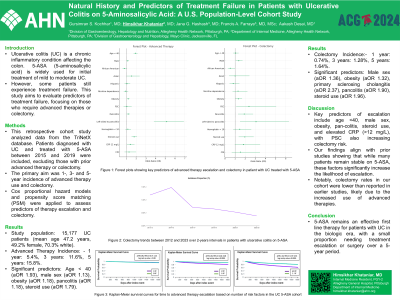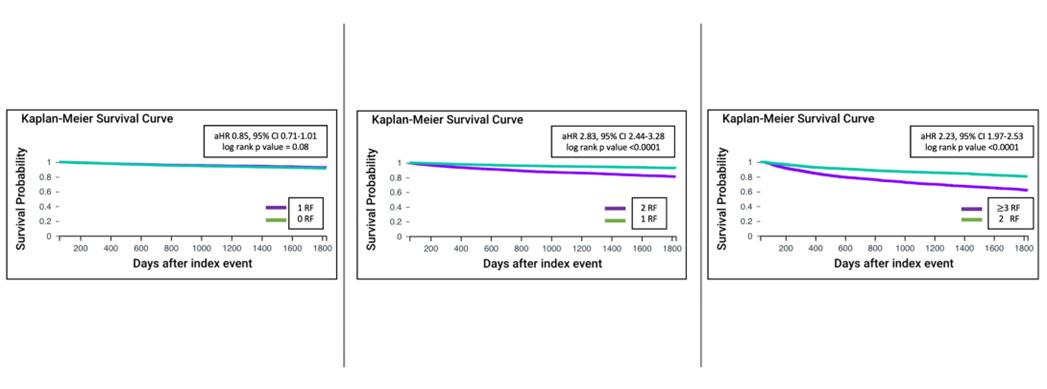Sunday Poster Session
Category: IBD
P0874 - Natural History and Predictors of Treatment Failure in Patients With Ulcerative Colitis on 5-Aminosalicylic Acid: A U.S. Population-Level Cohort Study
Sunday, October 27, 2024
3:30 PM - 7:00 PM ET
Location: Exhibit Hall E

Has Audio

Himsikhar Khataniar, MD
Allegheny General Hospital
Pittsburgh, PA
Presenting Author(s)
Gursimran S. Kochhar, MD1, Himsikhar Khataniar, MD1, Jana G. Hashash, MD, MSc2, Francis A. Farraye, MD, MSc2, Aakash Desai, MD3
1Allegheny General Hospital, Pittsburgh, PA; 2Mayo Clinic, Jacksonville, FL; 3Mayo Clinic, Pittsburgh, PA
Introduction: There is limited data on the natural history of ulcerative colitis (UC) in patients treated with 5-aminosalicylic acid (5-ASA) in the biologic era.
Methods: This was a retrospective cohort study utilizing TriNetX database on patients with UC who were initiated on 5-ASA between 2015-2019. The 1-, 3-, and 5-year incidence rates of advanced therapy use, and colectomy were calculated. Predictors of advanced therapy use and colectomy within 5 years were analyzed and expressed as adjusted odds ratio (aOR) with 95% confidence intervals (CI) after 1:1 propensity score matching (PSM).
Results: Among 15,177 patients in the UC 5-ASA cohort (mean age 47.2 ± 19.1 years old, 49.2% female and 70.3% white), the 1-, 3- and 5-year incidence of advanced therapy use was 5.4%, 11.6% and 15.8% respectively. After PSM, age < 40 years old (aOR 1.93, 95% CI 1.73-2.15), male sex (aOR 1.13, 1.02-1.25), obesity (aOR 1.18, 95% CI 1.05-1.31), pancolitis (aOR 1.18, 95% CI 1.03-1.36), steroid use (aOR 1.79, 95% CI 1.53-2.09) and CRP 12 mg/L (aOR 1.39, 95% CI 1.05-1.83) prior to 5-ASA initiation, were associated with advanced therapy use within 5 years. The 1-, 3- and 5-year incidence of colectomy was 0.74 %, 1.28% and 1.64% respectively. After PSM, male sex (aOR 1.36, 95% 1.06-1.74), obesity (aOR 1.32, 95% CI 1.02-1.69), primary sclerosing cholangitis (aOR 2.37, 95% CI 1.11-5.06), pancolitis (aOR 1.90, 95% CI 1.29-2.78) and steroid use (aOR 1.96, 95% CI 1.35-2.84) were associated with colectomy within 5 years. Moderate-severe anemia at the time of 5-ASA initiation did not predict advanced therapy use or colectomy. Our model showed that patients with 2 or more risk factors predicted advanced therapy use within 5 years.
Discussion: Our study indicates that 5-ASA could be an appropriate choice for initial therapy in certain patients with UC with low colectomy rates over five year. Our study also identified key predictors of advanced therapy utilization and colectomy in patients with UC on 5-ASA in the biologic era.

Note: The table for this abstract can be viewed in the ePoster Gallery section of the ACG 2024 ePoster Site or in The American Journal of Gastroenterology's abstract supplement issue, both of which will be available starting October 27, 2024.
Disclosures:
Gursimran S. Kochhar, MD1, Himsikhar Khataniar, MD1, Jana G. Hashash, MD, MSc2, Francis A. Farraye, MD, MSc2, Aakash Desai, MD3. P0874 - Natural History and Predictors of Treatment Failure in Patients With Ulcerative Colitis on 5-Aminosalicylic Acid: A U.S. Population-Level Cohort Study, ACG 2024 Annual Scientific Meeting Abstracts. Philadelphia, PA: American College of Gastroenterology.
1Allegheny General Hospital, Pittsburgh, PA; 2Mayo Clinic, Jacksonville, FL; 3Mayo Clinic, Pittsburgh, PA
Introduction: There is limited data on the natural history of ulcerative colitis (UC) in patients treated with 5-aminosalicylic acid (5-ASA) in the biologic era.
Methods: This was a retrospective cohort study utilizing TriNetX database on patients with UC who were initiated on 5-ASA between 2015-2019. The 1-, 3-, and 5-year incidence rates of advanced therapy use, and colectomy were calculated. Predictors of advanced therapy use and colectomy within 5 years were analyzed and expressed as adjusted odds ratio (aOR) with 95% confidence intervals (CI) after 1:1 propensity score matching (PSM).
Results: Among 15,177 patients in the UC 5-ASA cohort (mean age 47.2 ± 19.1 years old, 49.2% female and 70.3% white), the 1-, 3- and 5-year incidence of advanced therapy use was 5.4%, 11.6% and 15.8% respectively. After PSM, age < 40 years old (aOR 1.93, 95% CI 1.73-2.15), male sex (aOR 1.13, 1.02-1.25), obesity (aOR 1.18, 95% CI 1.05-1.31), pancolitis (aOR 1.18, 95% CI 1.03-1.36), steroid use (aOR 1.79, 95% CI 1.53-2.09) and CRP 12 mg/L (aOR 1.39, 95% CI 1.05-1.83) prior to 5-ASA initiation, were associated with advanced therapy use within 5 years. The 1-, 3- and 5-year incidence of colectomy was 0.74 %, 1.28% and 1.64% respectively. After PSM, male sex (aOR 1.36, 95% 1.06-1.74), obesity (aOR 1.32, 95% CI 1.02-1.69), primary sclerosing cholangitis (aOR 2.37, 95% CI 1.11-5.06), pancolitis (aOR 1.90, 95% CI 1.29-2.78) and steroid use (aOR 1.96, 95% CI 1.35-2.84) were associated with colectomy within 5 years. Moderate-severe anemia at the time of 5-ASA initiation did not predict advanced therapy use or colectomy. Our model showed that patients with 2 or more risk factors predicted advanced therapy use within 5 years.
Discussion: Our study indicates that 5-ASA could be an appropriate choice for initial therapy in certain patients with UC with low colectomy rates over five year. Our study also identified key predictors of advanced therapy utilization and colectomy in patients with UC on 5-ASA in the biologic era.

Figure: Kaplan-Meier survival curves for time to advanced therapy escalation based on number of risk factors in the UC 5-ASA cohort
RF: risk factor(s); aHR: adjusted hazard ratios, CI: confidence interval
RF: risk factor(s); aHR: adjusted hazard ratios, CI: confidence interval
Note: The table for this abstract can be viewed in the ePoster Gallery section of the ACG 2024 ePoster Site or in The American Journal of Gastroenterology's abstract supplement issue, both of which will be available starting October 27, 2024.
Disclosures:
Gursimran Kochhar: Boston Scientific Endoscopy – Consultant. DigbI – Stock Options. Eli Lilli – Advisory Committee/Board Member, Speakers Bureau. Olympus Endoscopy – Consultant. Pentax Endoscopy – Consultant. Takeda – Consultant.
Himsikhar Khataniar indicated no relevant financial relationships.
Jana Hashash: Bristol Myers Squibb – Consultant.
Francis Farraye: AbbVie – Consultant. Avalo Therapeutics – Consultant. Bausch – Advisor or Review Panel Member. BMS – Consultant. Braintree Labs – Consultant. DSMB for Lilly. – Sits on. Fresenius Kabi – Consultant. GI Reviewers and IBD Educational Group – independent contractor. GSK, Iterative Health, Janssen, Pfizer, Pharmacosmos, Sandoz Immunology, Sebela and Viatris – Consultant.
Aakash Desai indicated no relevant financial relationships.
Gursimran S. Kochhar, MD1, Himsikhar Khataniar, MD1, Jana G. Hashash, MD, MSc2, Francis A. Farraye, MD, MSc2, Aakash Desai, MD3. P0874 - Natural History and Predictors of Treatment Failure in Patients With Ulcerative Colitis on 5-Aminosalicylic Acid: A U.S. Population-Level Cohort Study, ACG 2024 Annual Scientific Meeting Abstracts. Philadelphia, PA: American College of Gastroenterology.
